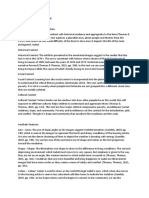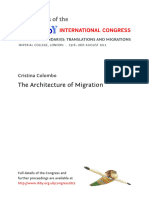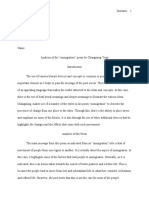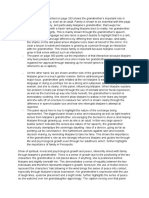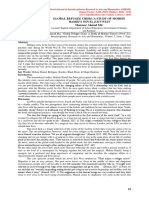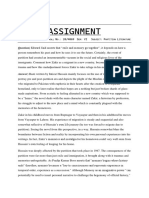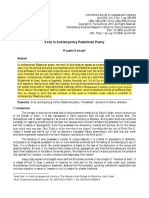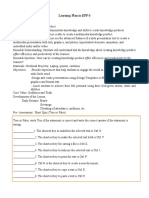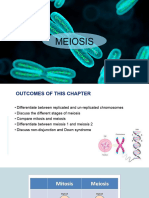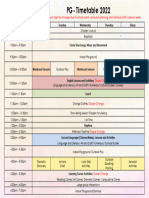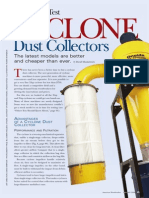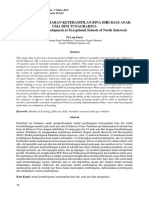The global issue I will be exploring is the psychological and emotional toll of forced
displacement and how refugees experience a loss of identity, balance, and agency.
Persepolis and Flee demonstrate that forced migration is not just a physical movement but a
process that disrupts an individual’s sense of self and belonging. Through graphic weight,
panel sequencing, and facial expressions in Persepolis, and perspective distortion, sound
design, and color symbolism in Flee, both works show how displacement isolates
individuals, forces them into survival mode, and makes the reconstruction of identity an
ongoing struggle.
Marjane Satrapi’s Persepolis is a graphic memoir that follows her childhood during the
Iranian Revolution, exploring the effects of war, exile, and cultural displacement. Marjane
faces alienation and identity crises as she moves between Iran and Europe. Similarly, Flee,
directed by Jonas Poher Rasmussen, is an animated documentary about Amin Nawabi, an
Afghan refugee who flees his home country as a child and struggles with the long-term
consequences of displacement. While Persepolis uses high-contrast black-and-white
imagery, Flee employs animation with shifting visual styles to reflect memory and trauma.
Despite their different formats, both works use their respective visual and narrative
techniques to illustrate how forced migration strips individuals of control over their lives and
forces them to exist in a state of emotional and psychological instability.
One of the most significant visual techniques Satrapi employs in Persepolis is graphic
weight, which conveys exile's emotional and psychological impact. On Page 153, the black
background surrounding Marjane as she walks away from her parents isolates her within the
panel, emphasizing her solitude. The contrast between her dark figure and the empty white
space reflects her emotional detachment, reinforcing how displacement separates
individuals from their past and leaves them unanchored. The final panel, where Marjane is
drawn smaller as she moves further away while her parents remain static, visually
represents the rupture caused by separation. This connects to the global issue by illustrating
that displacement does not merely change one’s physical environment—it disrupts one’s
sense of security and belonging, leaving individuals in a state of disconnection.
Additionally, panel sequencing in Persepolis shows that exile is a gradual and painful
process rather than a singular moment of departure. As Marjane walks away, the panels
progressively shrink, making her figure appear smaller, which visually mirrors her diminishing
sense of self. The contrast between movement and stillness—Marjane walking while her
parents remain frozen—reinforces that forced migration creates a divide between those who
leave and those who stay. This sequence highlights how refugees must move forward
physically while remaining emotionally tied to the past, illustrating that displacement is not
just about finding safety but also about negotiating the psychological cost of losing a
homeland. By structuring the scene this way, Satrapi conveys that migration fractures
identity, forcing individuals into a state of uncertainty where they are neither fully present in
their new reality nor able to return to their past.
�Furthermore, facial expressions and body language reinforce the emotional impact of
banishment. In the farewell scene, Marjane’s mother clings to her, her eyes closed tightly,
while her father looks on in silence. The lack of dialogue amplifies the emotional weight,
making the separation feel irreversible. Marjane’s posture—rigid, head bowed—suggests an
internal conflict, as she is physically leaving but emotionally struggling with the departure.
These visual choices emphasize that moving is not just about geographic relocation but also
about emotional fragmentation. The pain in these expressions links to the global issue by
highlighting that emigration uproots individuals from the emotional and familial connections
that define their identity.
In Flee, perspective distortion is used to depict the dehumanizing experience of forced
migration. In the shipping container scene (Timestamp 45:12), Amin and other refugees are
crammed into a small space, with the walls appearing to close in unnaturally. This visual
manipulation heightens the sense of claustrophobia, making the audience experience the
lack of control that refugees face. The distortion of space reflects Amin’s psychological
state—overwhelmed, powerless, and trapped. This technique connects to the global issue
by showing that relocation is not only about physical movement but also about the loss of
agency, as refugees are placed in conditions where they have no control over their survival.
Sound design in Flee also emphasizes the psychological toll of exile. In the boat scene, as
Amin and other refugees are crammed together in the dark, the only sounds present are the
rhythmic crashing of waves, the creaking of the boat, and hushed murmurs of fear. The
absence of a musical score intensifies the moment, immersing the audience in the refugees’
vulnerability. At one point, the panic escalates as the smugglers bark orders, and the threat
of being cast overboard looms heavily over the passengers. The whispered exchanges and
restrained breathing highlight how refugees must suppress their presence to survive. By
stripping the scene of background noise, Rasmussen mirrors how displacement erases
individuals from public consciousness, leaving them unheard and unseen. This links to the
global issue by illustrating that immigration not only forces individuals into physical danger
but also into a state of social invisibility, where their survival depends on their ability to
remain unnoticed.
Finally, color symbolism in Flee visually represents the emotional toll of expulsion. Amin’s
memories of his childhood in Afghanistan are depicted in warm, vibrant tones, contrasting
with the muted, desaturated colors of his refugee journey. This visual shift highlights the loss
of warmth and stability in his life. As his past is depicted in full color, it suggests that his
sense of self was intact before displacement, whereas the dull tones of his present illustrate
the emptiness and uncertainty he feels after years of exile. This technique reinforces the
idea that displacement not only removes individuals from their homeland but also alters their
perception of identity, making it difficult to find stability in a new place. The use of color,
therefore, directly connects to the global issue by showing that relocation is not just about
escaping physical danger but also about losing the emotional and psychological foundation
that once provided a sense of self.
In conclusion, both Persepolis and Flee depict the psychological and emotional
consequences of forced displacement, demonstrating that relocation is not simply about
migration but about the long-term impact it has on an individual’s sense of identity and
stability. Satrapi’s use of graphic weight, panel sequencing, and facial expressions in
�Persepolis conveys the isolation and loss of self that comes with separation. In contrast,
Rasmussen’s use of perspective distortion, sound design, and color symbolism in Flee
highlights the dehumanization and erasure that refugees experience. Therefore, immerses
the audience in the protagonists’ fragmented realities, emphasizing that exile is not a single
event but a continuous struggle to reconstruct identity in unfamiliar and often unwelcoming
environments. Ultimately, both works illustrate that forced migration is not just about
survival—it is about the difficulty of reclaiming one’s identity in the aftermath of displacement.
� 1. Global Issue → The psychological and emotional toll of forced displacement, where
refugees experience loss of identity, stability, and agency. (Persepolis and Flee show
that forced migration is not just physical but fractures identity and belonging.)
Persepolis - Visual Techniques
2. Graphic Weight (Page 153) → A black background surrounds Marjane, isolates her,
and contrasts her dark figure with space. This reflects emotional detachment and
disconnection from security and belonging.
3. Panel Sequencing → Shrinking panels as Marjane walks away emphasize her
diminishing sense of self. The contrast between movement (Marjane) and stillness
(her parents) shows the emotional divide caused by migration.
4. Facial Expressions & Body Language → Marjane’s mother clings to her, eyes closed
in grief, while her father stays silent. Marjane’s rigid posture shows emotional
struggle, reinforcing that exile is physical and emotional fragmentation.
Flee - Film Techniques
5. Perspective Distortion (Shipping Container Scene - 45:12) → Walls close in
unnaturally, creating claustrophobia. This reflects Amin’s psychological
state—powerless and trapped—showing how displacement leads to a loss of agency.
6. Sound Design (Boat Scene) → No music, just waves, creaking, and hushed voices.
Smugglers bark orders, refugees must suppress their presence. The absence of
background noise symbolizes how displacement erases refugees from public
consciousness.
7. Color Symbolism → Warm, vibrant tones in childhood memories contrast with
desaturated, dull colors in exile. This shift represents the loss of warmth and stability,
showing how displacement alters one’s perception of identity.
Conclusion & Final Link to Global Issue
8. Persepolis (Graphic Weight, Panel Sequencing, Facial Expressions) → Shows
isolation, emotional fragmentation, and loss of self due to exile.
9. Flee (Perspective Distortion, Sound Design, Color Symbolism) → Highlights
dehumanization, loss of control, and social invisibility that refugees face.
10.Final Message → Forced migration is not just about survival but about the struggle to
reclaim identity in the aftermath of displacement.











